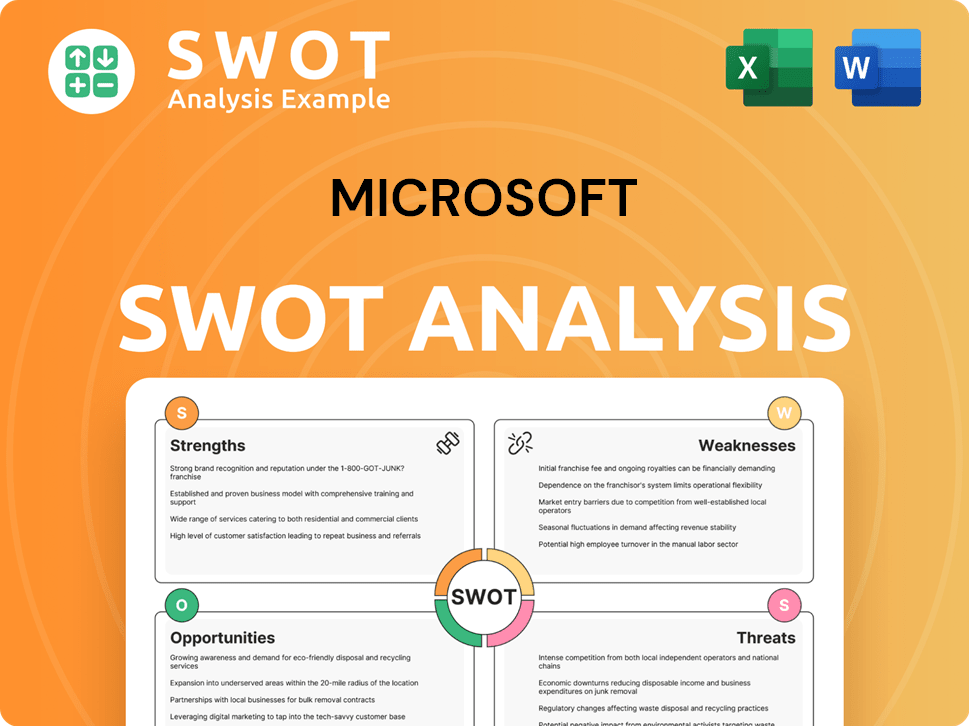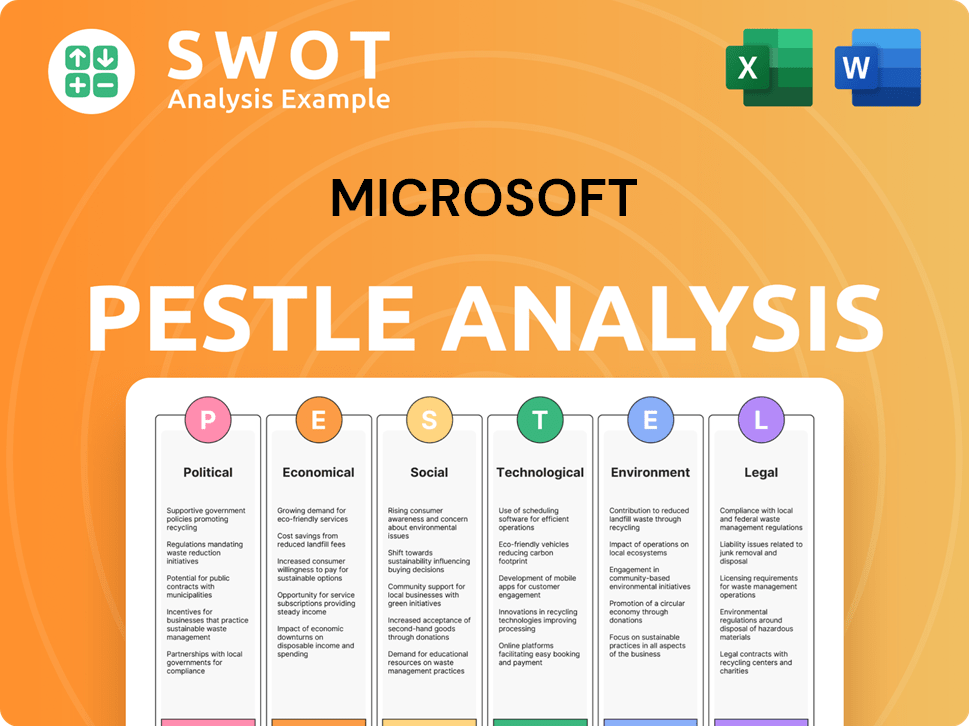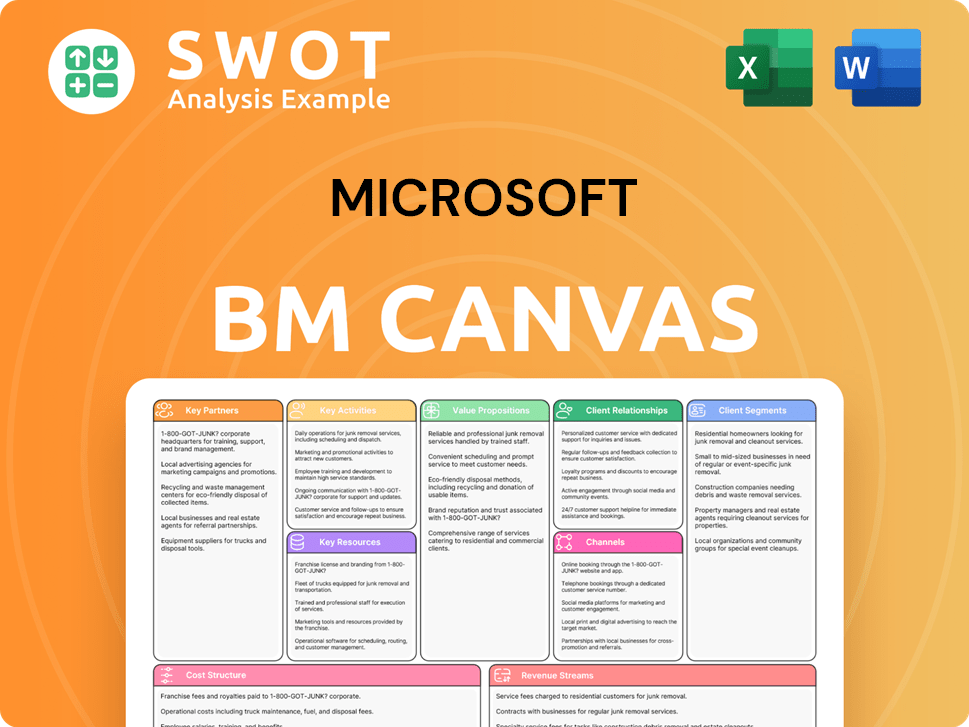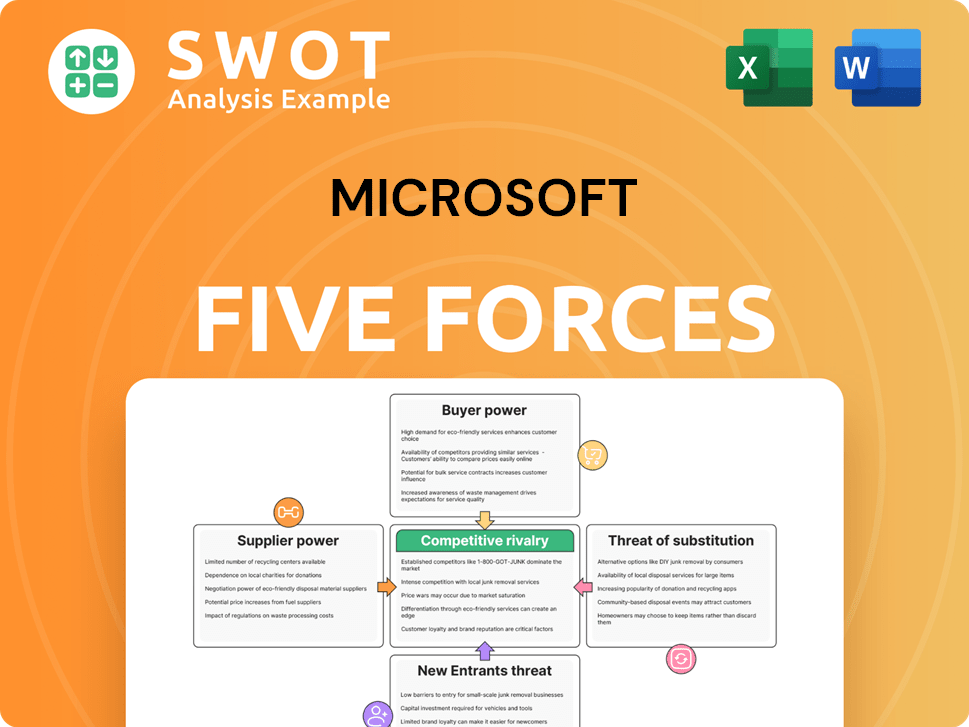Microsoft Bundle
How Does Microsoft Dominate the Tech World?
From its humble beginnings to a multi-trillion-dollar valuation, Microsoft's journey is a testament to its relentless pursuit of innovation. Its strategic moves in artificial intelligence and cloud computing have reshaped the tech landscape, sparking fierce competition. Understanding the Microsoft SWOT Analysis is key to grasping its market position and future potential.

This exploration of the Microsoft competitive landscape will dissect its key rivals and analyze how Microsoft maintains its edge in the software market share. We'll examine Microsoft's industry analysis, exploring its competitive advantages and strategies, and how it responds to emerging technologies and competitors. Delving into Microsoft's main rivals in cloud computing, gaming, and other sectors will provide a comprehensive understanding of its dynamic environment.
Where Does Microsoft’ Stand in the Current Market?
Microsoft maintains a robust market position across various high-growth sectors. Its dominance in the operating system market, cloud computing, and enterprise productivity software solidifies its status as a tech industry leader. Understanding the Microsoft competitive landscape is crucial for appreciating its sustained success and future prospects.
The company's strategic shift towards a cloud-first, subscription-based model, highlighted by the success of Azure and Microsoft 365, has been pivotal. This transformation allows for diversified offerings and recurring revenue streams, contributing significantly to its financial health. This shift is also a key factor in how Microsoft competitors are evaluated.
Geographically, Microsoft has a strong global presence. It caters to a diverse customer base, including individual consumers, SMBs, and large enterprises. Its ability to adapt to market changes and customer needs underscores its strong Microsoft market position.
Windows continues to lead the desktop OS market. As of March 2025, it holds approximately 72.5% of the market share, significantly outpacing macOS and Linux. This sustained dominance provides a solid foundation for its other ventures. For a deeper dive into the company's origins, consider reading a Brief History of Microsoft.
Azure is the second-largest global cloud provider. In Q4 2024, it captured around 23% of the cloud infrastructure services market. This position, though behind AWS, demonstrates substantial growth and influence in the cloud sector. Understanding this is vital for a comprehensive Microsoft industry analysis.
Microsoft 365 remains the industry standard. With over 300 million paid seats as of late 2024, it solidifies its leadership in enterprise productivity. This segment is a key area of competition in the tech company competition landscape.
Microsoft reported revenues of $61.9 billion in Q3 2024. The company's net income was $21.9 billion, showcasing its exceptional financial health. These figures highlight its scale and financial strength compared to industry averages, influencing its software market share.
Microsoft's revenue streams are diversified across North America, Europe, and Asia. The company serves a wide range of customers, from individual consumers to large enterprises, providing tailored solutions. This broad reach helps to mitigate risks and capitalize on diverse market opportunities.
- Strong presence in North America, Europe, and Asia.
- Caters to individual consumers, SMBs, and large enterprises.
- Offers tailored solutions to meet diverse customer needs.
- Faces intense competition in specific regions, like China.
Microsoft SWOT Analysis
- Complete SWOT Breakdown
- Fully Customizable
- Editable in Excel & Word
- Professional Formatting
- Investor-Ready Format

Who Are the Main Competitors Challenging Microsoft?
Understanding the Microsoft competitive landscape is crucial for investors and industry analysts. The company faces diverse competition across its vast portfolio of products and services. This analysis provides insights into key rivals and their impact on Microsoft's market position.
Microsoft competitors span various sectors, from cloud computing and productivity software to gaming and hardware. The competitive dynamics are constantly evolving, influenced by technological advancements, strategic alliances, and market trends. This overview highlights the major players and their strategies in the Microsoft industry analysis.
Microsoft's competitive environment is shaped by a mix of direct and indirect competitors. These rivals challenge Microsoft's dominance, driving innovation and influencing market share. Analyzing these competitors provides a comprehensive view of the challenges and opportunities facing Microsoft.
Amazon Web Services (AWS) is a primary competitor in cloud computing, holding a significant market share. Google Cloud Platform (GCP) also poses a strong challenge, particularly in AI and data analytics. These companies compete fiercely on price, features, and enterprise solutions.
Google Workspace competes directly with Microsoft 365, offering a cloud-native alternative. While Microsoft 365 maintains market dominance, Google Workspace appeals to users seeking web-based solutions. The competition focuses on collaboration tools and ease of use.
Apple's macOS provides a premium alternative to Windows, especially in creative and professional segments. Linux distributions compete in server environments and niche markets. These competitors offer different user experiences and target specific user groups.
Sony's PlayStation and Nintendo's Switch are major competitors to Microsoft's Xbox. They compete through exclusive game titles, console hardware, and online services. The gaming market is highly competitive, with significant investments in content and platforms.
Dell, HP, and Lenovo compete with Microsoft's Surface devices in the PC hardware market. These companies offer a wide range of PCs, competing on price, features, and design. The hardware market is driven by innovation and consumer preferences.
Emerging players in AI and specialized software solutions pose indirect threats to Microsoft. These companies constantly innovate, potentially disrupting traditional market segments. The competitive landscape is dynamic, with new entrants and technologies emerging.
The Microsoft competitive landscape is influenced by mergers, acquisitions, and strategic alliances. For example, Salesforce's acquisition of Slack intensified competition in enterprise communication tools. Microsoft continues to adapt its strategies to maintain its competitive edge.
- Cloud Computing: Microsoft invests heavily in Azure to compete with AWS and GCP. In Q1 2024, Azure's revenue grew by 31%.
- Productivity Software: Microsoft focuses on integrating AI features into Microsoft 365 to compete with Google Workspace.
- Gaming: Microsoft acquired Activision Blizzard to strengthen its position against Sony and Nintendo. The deal closed in October 2023.
- Hardware: Microsoft continues to innovate with Surface devices, competing with established PC manufacturers.
- AI: Microsoft is investing heavily in AI, integrating it across its products and services to compete with Google and other AI-focused companies.
To understand the broader picture, consider reading about the Marketing Strategy of Microsoft.
Microsoft PESTLE Analysis
- Covers All 6 PESTLE Categories
- No Research Needed – Save Hours of Work
- Built by Experts, Trusted by Consultants
- Instant Download, Ready to Use
- 100% Editable, Fully Customizable

What Gives Microsoft a Competitive Edge Over Its Rivals?
The Microsoft competitive landscape is shaped by its robust competitive advantages, which have evolved from its early dominance in desktop software to its current leadership in cloud and AI. These advantages are multifaceted, stemming from proprietary technologies, immense brand equity, and vast economies of scale. The company's ability to adapt and innovate has been crucial in maintaining its market position against formidable Microsoft competitors.
Microsoft's strategic moves, including significant investments in global data center infrastructure, advanced AI capabilities, and strategic partnerships, have expanded its reach and diversified its offerings. Its continuous investment in R&D and its established ecosystem make these advantages highly sustainable, though constant innovation is required to fend off rivals. These factors contribute significantly to Microsoft's market position.
Microsoft's core competitive advantages include its Windows operating system and Office suite, which foster strong customer loyalty and create high switching costs. Azure, its cloud platform, benefits from significant investments, competitive pricing, and robust service level agreements (SLAs). Its strong brand recognition, built over decades, instills trust among consumers and businesses alike.
Windows and Office suite create a strong ecosystem, fostering customer loyalty and high switching costs. The extensive network effect of its products, particularly in the business world, ensures continued adoption and integration. These proprietary technologies form a significant barrier to entry for potential competitors.
Microsoft's strong brand recognition, built over decades, instills trust and reliability among consumers and businesses. This brand equity is a key factor in customer decisions and helps in maintaining market share. The company's reputation for quality and innovation further strengthens its brand value.
Azure benefits from significant investments in global data center infrastructure and advanced AI capabilities. It offers a comprehensive suite of services, competitive pricing, and robust SLAs, making it attractive to large corporations. Azure's growth is a key indicator of Microsoft's success in the cloud market.
Microsoft holds a vast intellectual property portfolio, including numerous patents in software, AI, and cloud technologies. The company leverages its deep talent pool, particularly in AI research and development, to drive innovation. Strategic partnerships and acquisitions further expand its reach.
Microsoft's strengths include a strong ecosystem, brand recognition, and cloud computing capabilities. Its strategies involve continuous investment in R&D, strategic partnerships, and acquisitions. These strategies are crucial for maintaining a competitive edge in the evolving tech industry.
- Strong Ecosystem: Windows and Office create a loyal customer base.
- Cloud Dominance: Azure's growth is a key focus area.
- Innovation: Continuous investment in AI and new technologies.
- Strategic Partnerships: Expanding reach and diversifying offerings.
Microsoft Business Model Canvas
- Complete 9-Block Business Model Canvas
- Effortlessly Communicate Your Business Strategy
- Investor-Ready BMC Format
- 100% Editable and Customizable
- Clear and Structured Layout

What Industry Trends Are Reshaping Microsoft’s Competitive Landscape?
The competitive landscape for Microsoft is a dynamic environment shaped by rapid technological advancements and shifting market dynamics. Industry trends such as artificial intelligence (AI), cloud computing, and cybersecurity significantly influence Microsoft's market position. Understanding these trends is crucial for assessing Microsoft's strengths, weaknesses, and future prospects. This analysis considers the key players, market dynamics, and strategic initiatives shaping Microsoft's competitive environment.
Microsoft faces a complex interplay of risks and opportunities. Potential threats include increased regulatory scrutiny and economic downturns, while significant growth opportunities exist in emerging markets and product innovations. The company's ability to adapt to these challenges and leverage emerging opportunities will determine its future success. For a deeper dive into the ownership structure, consider exploring the Owners & Shareholders of Microsoft.
The tech industry is currently driven by AI, cloud computing, and cybersecurity. Microsoft is investing heavily in AI, integrating it across its products, such as Copilot. The cloud market continues to grow, with Azure competing for market share. Cybersecurity is also a major focus, with increasing demand for robust security solutions.
Microsoft faces challenges such as regulatory scrutiny, particularly concerning antitrust and data privacy. Economic downturns could reduce IT spending, impacting software and cloud service revenues. Competition in the cloud market is fierce, potentially leading to price wars and the need for differentiated services.
Significant growth opportunities exist in emerging markets, where digital transformation is still in its early stages. Product innovations, particularly in AI-powered applications and mixed reality, offer new avenues for growth. Strategic partnerships in niche industries or with emerging tech companies can further expand Microsoft's ecosystem.
Microsoft's strategy involves deeper AI integration, a stronger focus on industry-specific cloud solutions, and expansion into new hardware categories. This approach aims to maintain a competitive edge and drive future growth. The company is likely to continue investing heavily in R&D to stay ahead of competitors.
Microsoft's competitive advantages include its established brand, extensive product portfolio, and strong enterprise presence. Its main rivals include Google, Amazon, and Apple. Microsoft's market position is influenced by its ability to innovate and adapt to changing market demands. The company is focusing on AI, cloud services, and hardware to maintain its competitive edge.
- Cloud Computing: Microsoft Azure competes with Amazon Web Services (AWS) and Google Cloud. In Q1 2024, Microsoft's cloud revenue grew by 23%.
- AI: Microsoft is integrating AI across its products to compete with Google and others. Microsoft is investing billions in AI research and development.
- Operating Systems: Windows remains a dominant player, though it faces competition from macOS and open-source alternatives. Windows holds about 73% of the desktop OS market share as of early 2024.
- Productivity Software: Microsoft Office 365 competes with Google Workspace. Microsoft 365 has over 382 million subscribers as of the end of 2023.
Microsoft Porter's Five Forces Analysis
- Covers All 5 Competitive Forces in Detail
- Structured for Consultants, Students, and Founders
- 100% Editable in Microsoft Word & Excel
- Instant Digital Download – Use Immediately
- Compatible with Mac & PC – Fully Unlocked

Related Blogs
- What are Mission Vision & Core Values of Microsoft Company?
- What is Growth Strategy and Future Prospects of Microsoft Company?
- How Does Microsoft Company Work?
- What is Sales and Marketing Strategy of Microsoft Company?
- What is Brief History of Microsoft Company?
- Who Owns Microsoft Company?
- What is Customer Demographics and Target Market of Microsoft Company?
Disclaimer
All information, articles, and product details provided on this website are for general informational and educational purposes only. We do not claim any ownership over, nor do we intend to infringe upon, any trademarks, copyrights, logos, brand names, or other intellectual property mentioned or depicted on this site. Such intellectual property remains the property of its respective owners, and any references here are made solely for identification or informational purposes, without implying any affiliation, endorsement, or partnership.
We make no representations or warranties, express or implied, regarding the accuracy, completeness, or suitability of any content or products presented. Nothing on this website should be construed as legal, tax, investment, financial, medical, or other professional advice. In addition, no part of this site—including articles or product references—constitutes a solicitation, recommendation, endorsement, advertisement, or offer to buy or sell any securities, franchises, or other financial instruments, particularly in jurisdictions where such activity would be unlawful.
All content is of a general nature and may not address the specific circumstances of any individual or entity. It is not a substitute for professional advice or services. Any actions you take based on the information provided here are strictly at your own risk. You accept full responsibility for any decisions or outcomes arising from your use of this website and agree to release us from any liability in connection with your use of, or reliance upon, the content or products found herein.